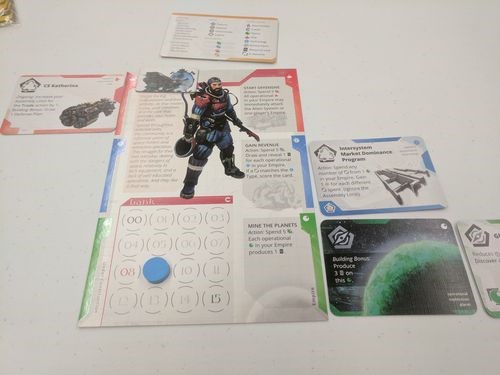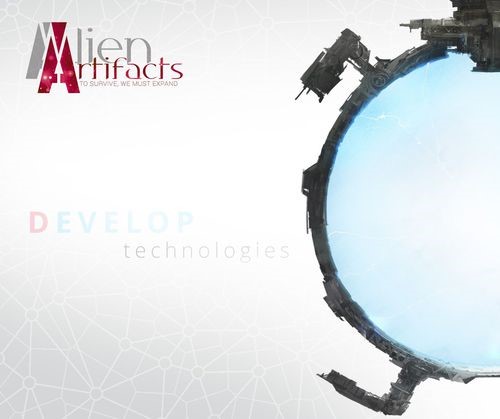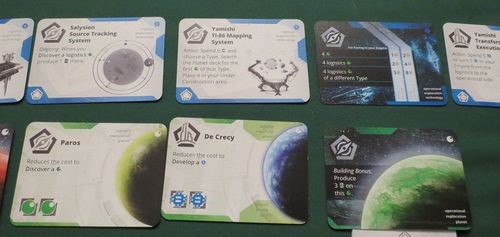
Released in 2017, Alien Artifacts is intergalactic engine builder in the style of a 4X card game and was an instant hit with fans. It’s not hard to see why I considered it my best science fiction board game in 2017.
Players choose factions that specialize in different areas—the clones are research-heavy, the community focuses on mining, the bionics are versatile and unpredictable, etc. Once a faction is chosen, the players perform basic setup actions and then the fun begins.

Playing the Game
Players perform one action per turn. Those actions can be buying cards with credits (marked by numbered circles on the player sheet) and placing them in the under-construction area, building a card previously purchased and adding it to the empire, attacking, gathering resources, mining planets, or trading resource cards for credits.
Cards cost credits and building costs resources, calculated by the position of the card along the row—as you grow your empire, the price goes up.




There are three areas of development that players can explore:
- The red segment is ships.
You can advance logistical ships to gain bonuses and other helpful boons to your empire or build operational ships to launch attacks on other players or alien systems.
Attacking other players allows you to blockade their cards, and an attack on alien systems might yield alien artifacts, powerful bonuses that will definitely give you an edge. - Blue is technology.
These cards give you advancements that allow you to buy cards at lower costs, perform extra actions, etc. The operational side lets you score victory points based on the number of certain types of cards you have built in your empire.
It’s entirely possible to win by focuses almost entirely on researching technologies and scoring them. - The green section holds planets.
Depending on whether they are operational or logistical planets, you can gain recurring bonuses or mine resource cards.
Mining generates resources and victory points, as well as supplying players with potential sources of income.
Winning the Game
Players win by accruing victory points. This can be done in a multitude of ways, and since different factions have different strengths, no two games will ever be exactly the same. It’s a fairly simple concept to master and focuses most of the player’s energy on their own activities, which often results in the winner being a surprise at the end of the game. I personally love it when it’s not super obvious who’s winning until the very end, and this is definitely one of those games. While players will bound ahead occasionally during gameplay, the final winner is never clear until the points are tallied.
Mechanics (5/5)
While there is a lot to keep straight in this game, the mechanics are intuitive to pick up and flow well between phases and turns. The rules make a lot of sense and mesh with the world, and since you can only take one action per turn, it’s hard to get overwhelmed.
Players have to balance strategizing in the long term with short term bursts of activity.
Gameplay (4/5)
This is a game that becomes less fun the more people you have.
I personally prefer the two or three player option, but this game can technically be played with up to 5 people. When you get above three, there’s a lot of waiting for other players to take their turns and rounds begin to drag.
But it’s pretty easy to pick up and first-time players can grasp everything competently enough to have a great time, while seasoned players can experiment with new strategies and factions. There are dozens of paths to victory and the options for combative or self-contained play offer fun for a variety of play styles and impressive replayability.
While every player is technically playing against the others and you can attack one another, you absolutely don’t have to play that way, and honestly aren’t particularly encouraged to do so as you only get artifacts from alien systems.
This option to play non-combatively gives new players and nonconfrontational players an excellent avenue to take. You are equally able to fight tooth and claw, which adds a level of player control of the experience that’s really valuable.




Components (4/5)
This game has awesome artwork and solid components.
Both the resource and construction cards are elegant and easy to shuffle, but they do get frayed on the edges fairly quickly; that’s a shame, because you’re constantly shuffling the deck between rounds which damages them. Otherwise the components are excellent.
The art is exquisite and thematically perfect, the factions are all incredibly unique and visually interesting, the little credit and victory tokens are the same size, shape, and color, which makes it easy to keep track of them and satisfying to move the counters.
The game board has perfectly sized slots for cards, and although you’ll have to spread out on a large surface to properly view your sprawling empire, the setup makes it easy to take the game to the floor if need be. Everything goes back into a nice insert that keeps everything contained and organized.
Final Thoughts
This is a really solid game with good components and smooth mechanics. The complexity comes from the players’ strategizing and not an overabundance of rules, and it offers a range of experiences for almost every player with any interest in engine builders.
It’s one of my personal favorites and I highly recommend it to any sci-fi fan.


Be the first to comment